
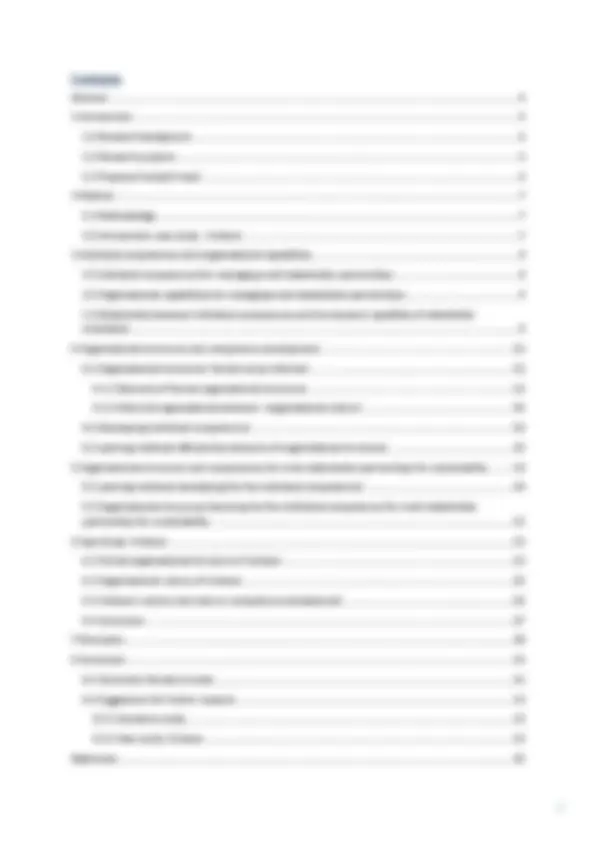

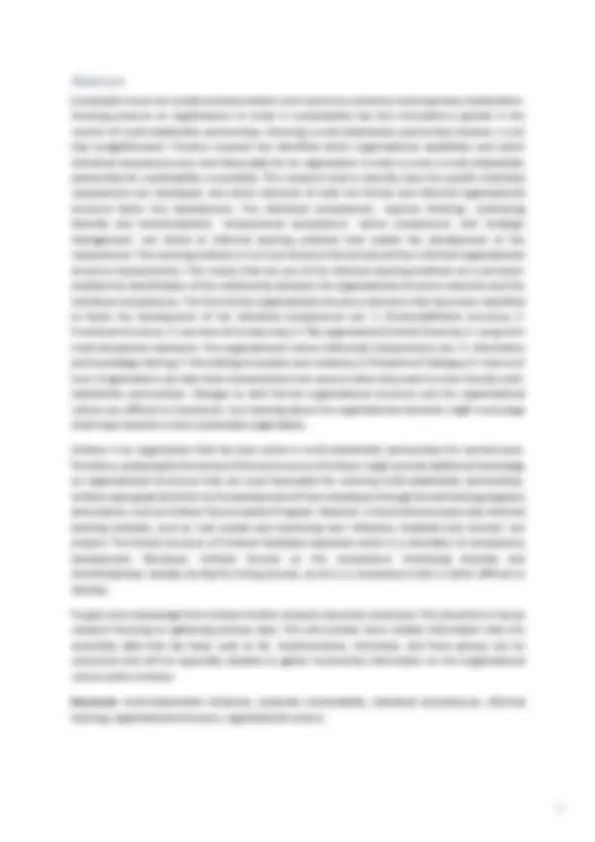
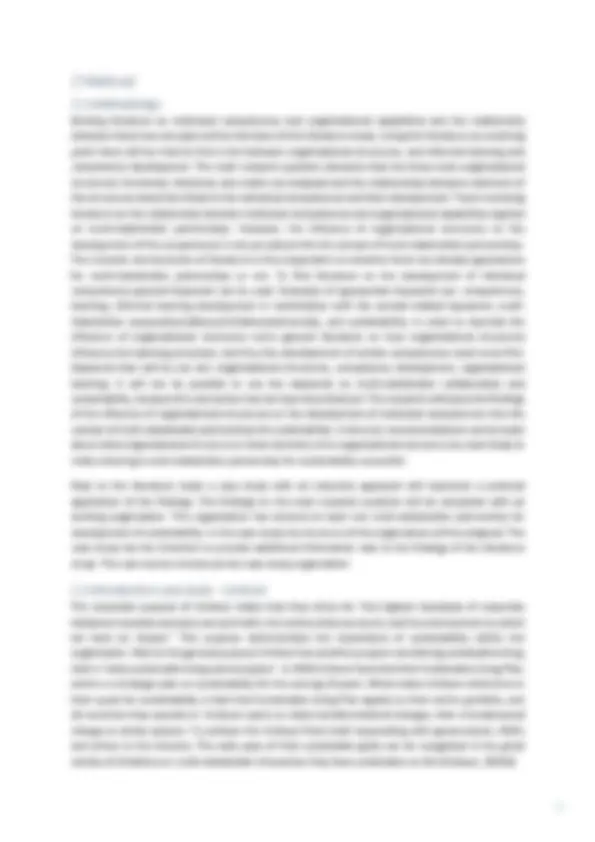
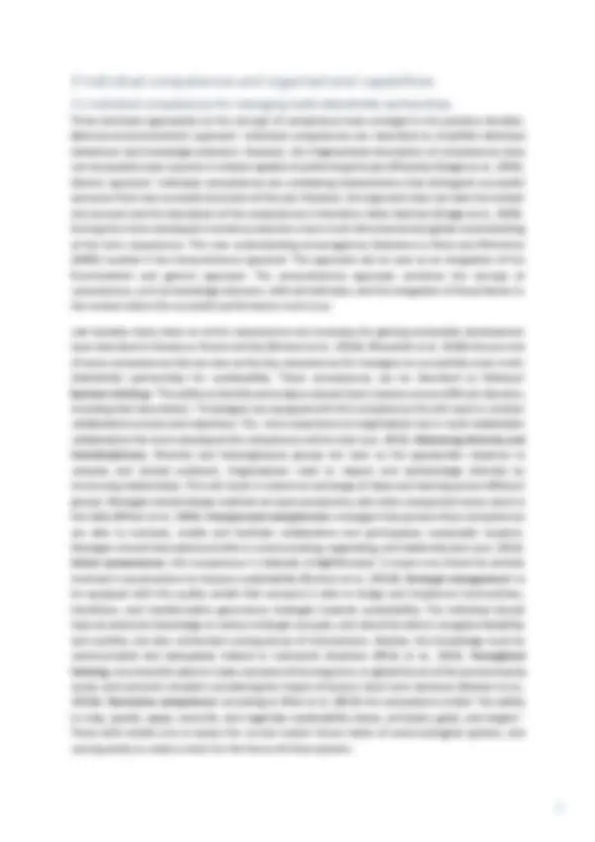

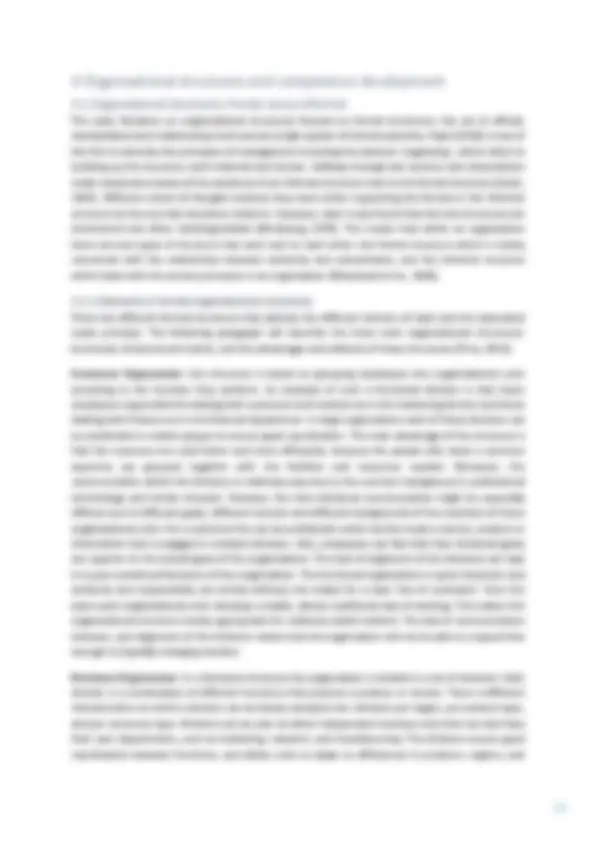
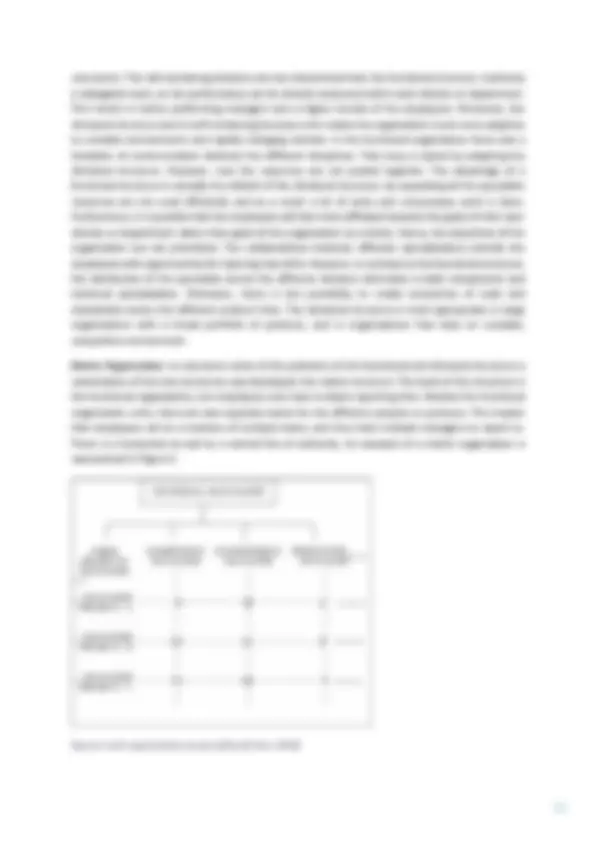
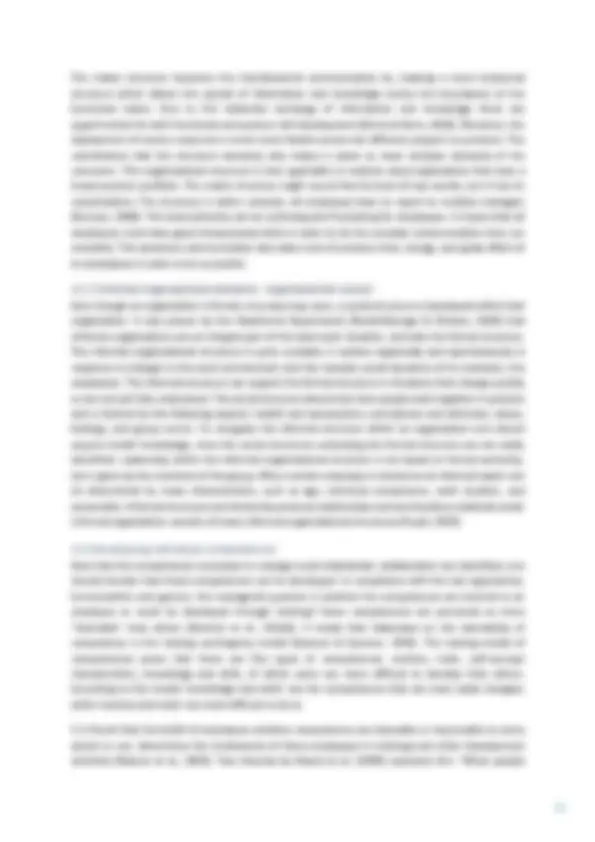
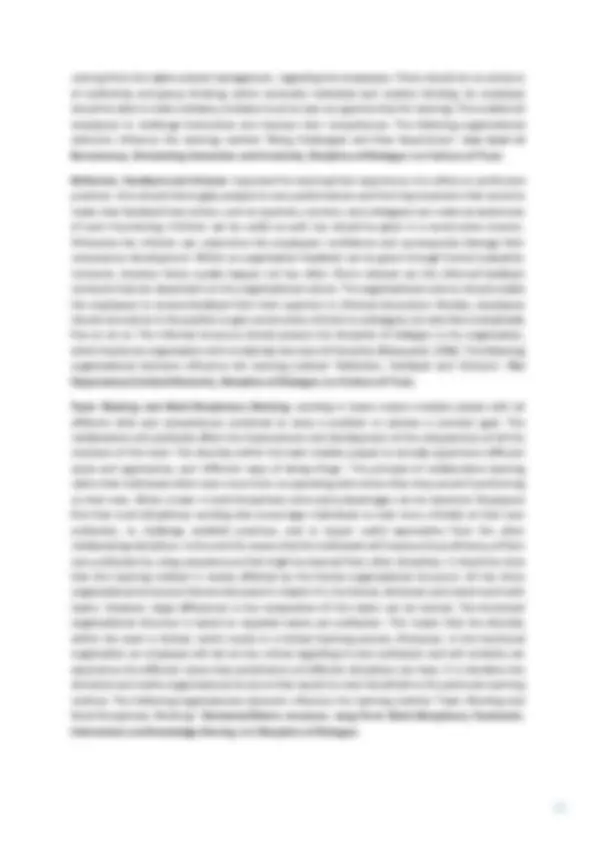
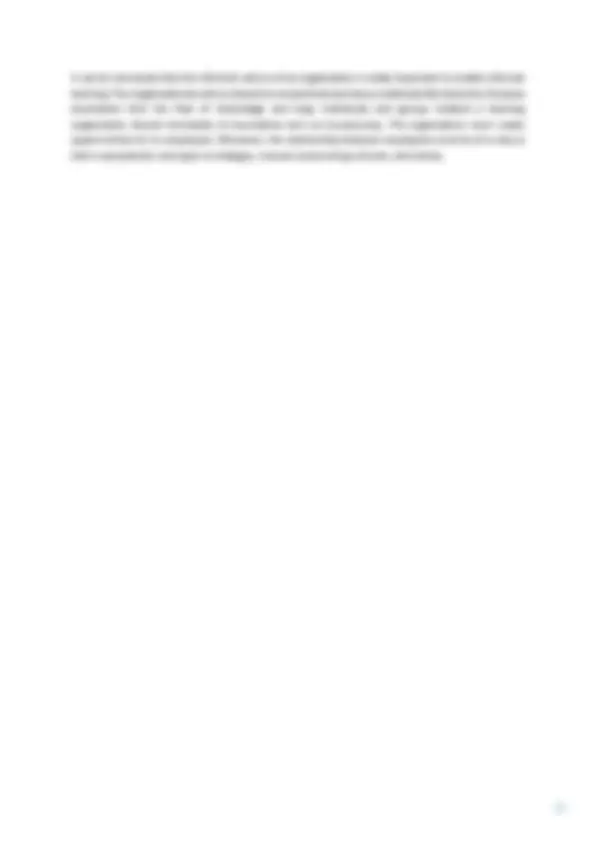

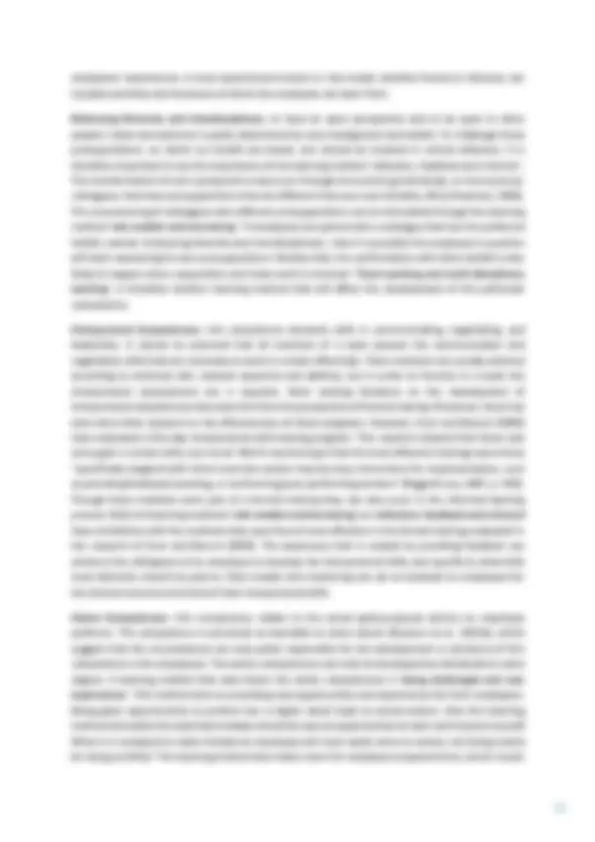
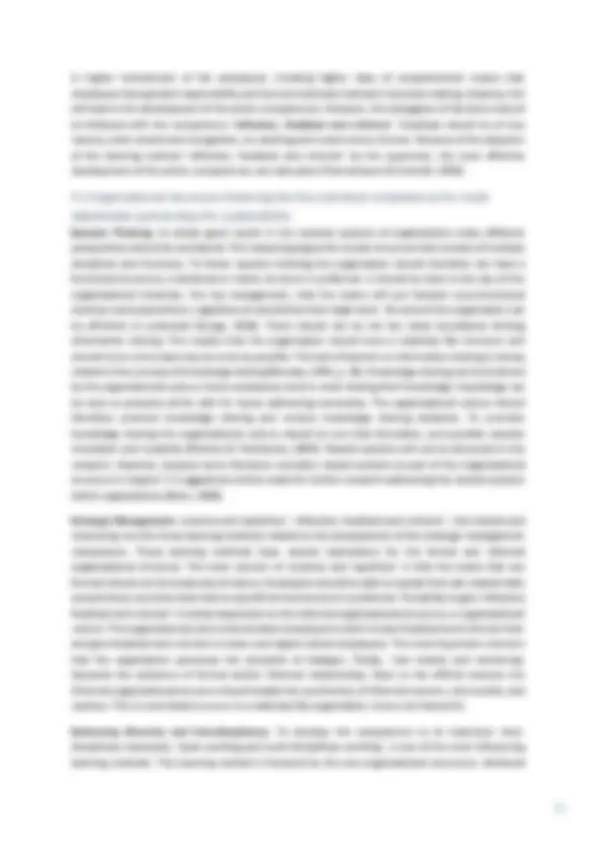

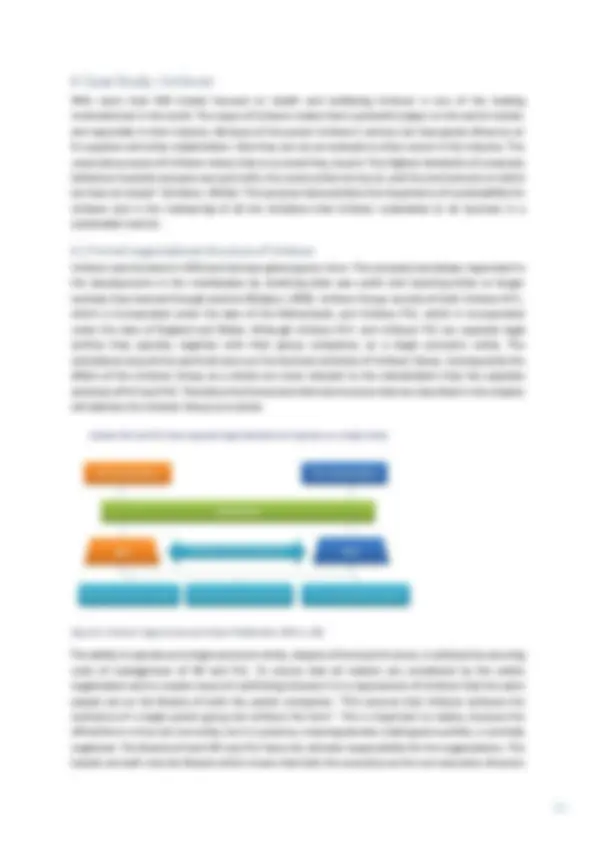

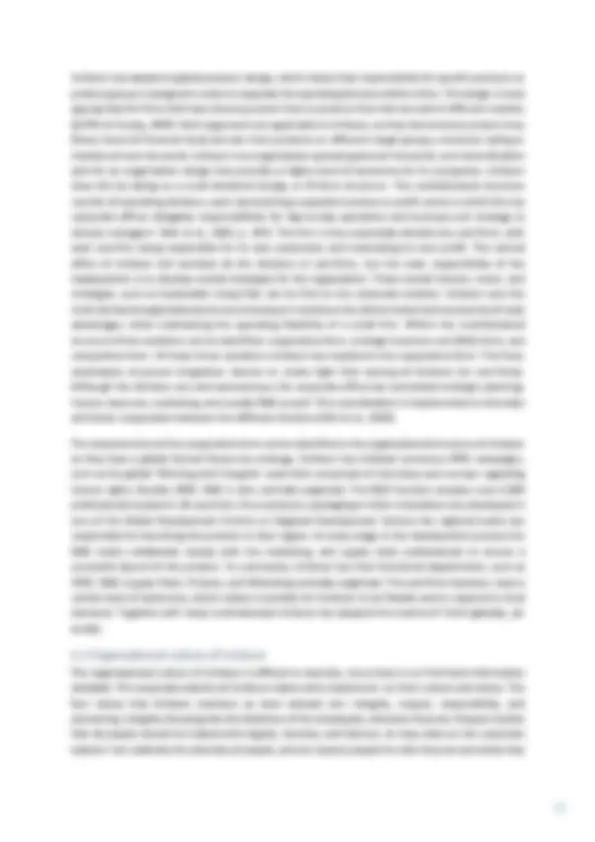
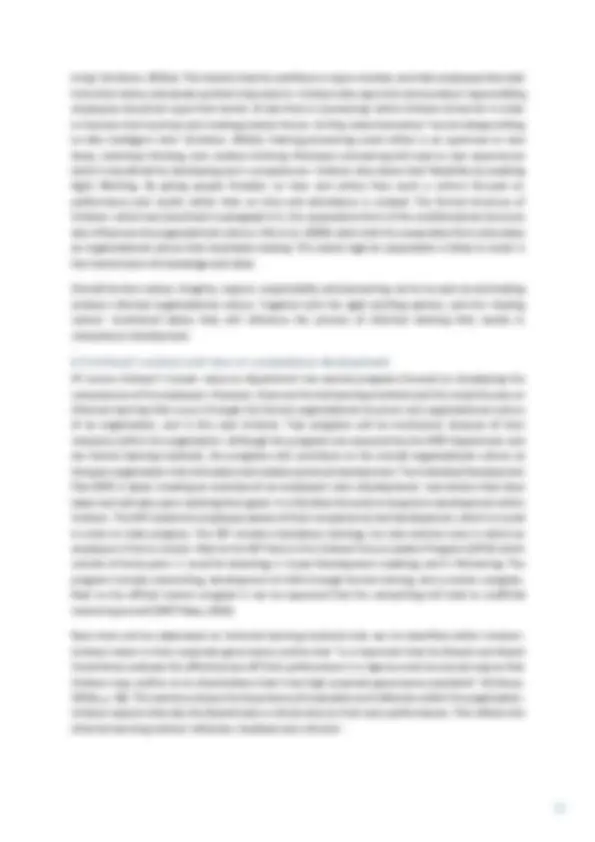
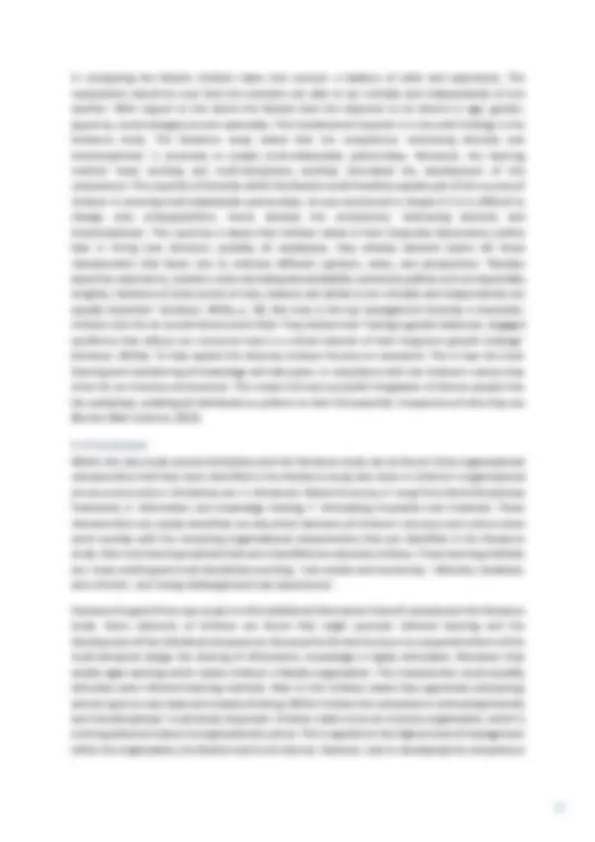
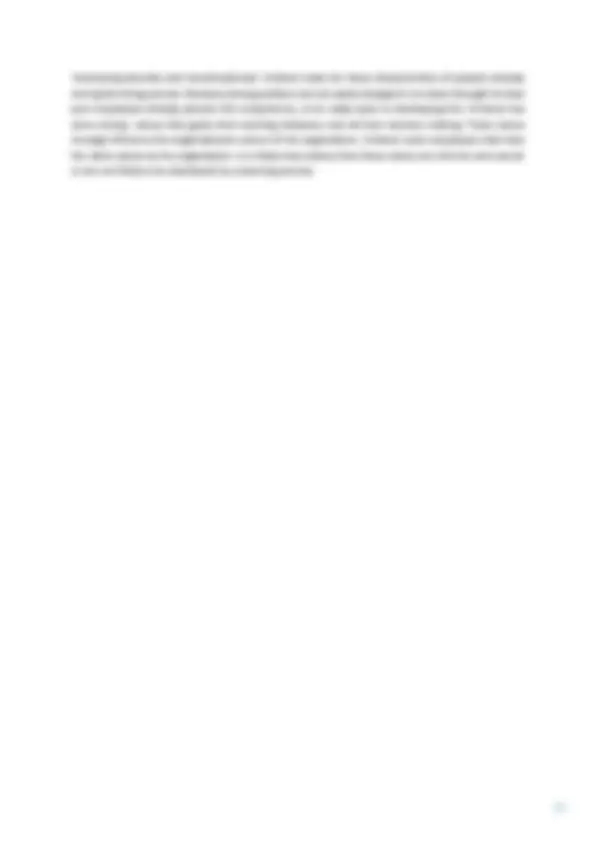
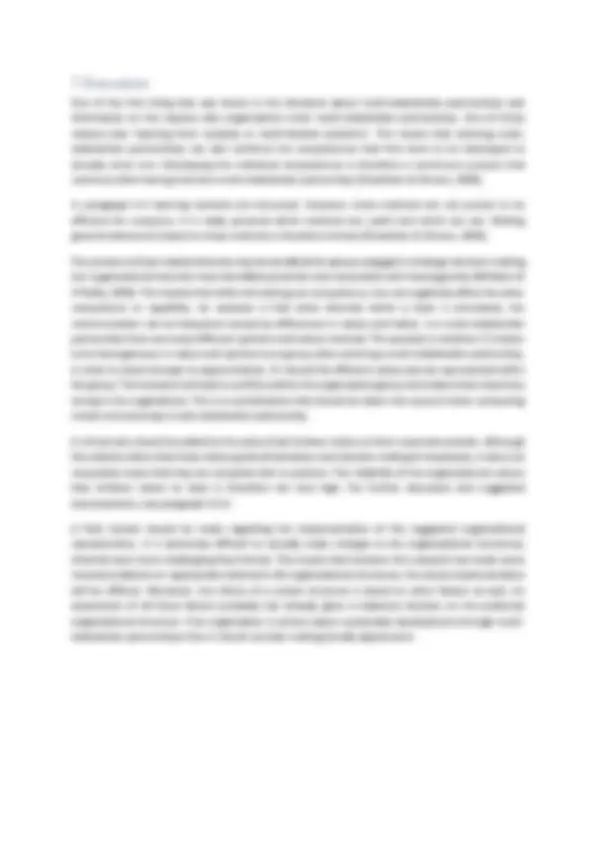
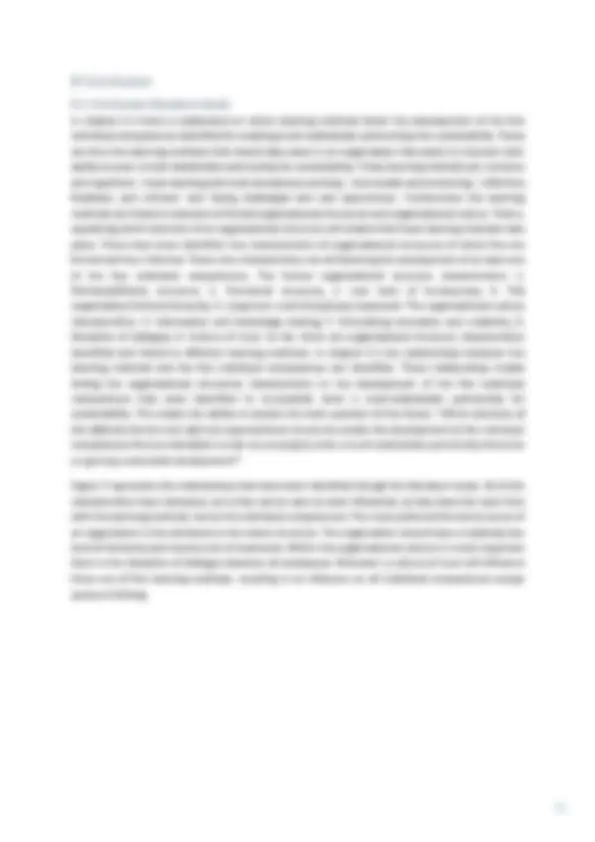
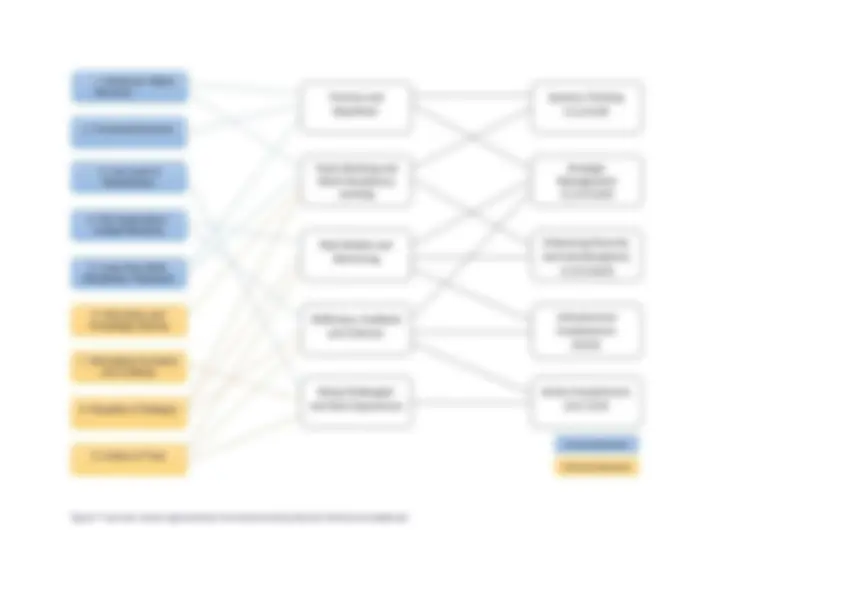
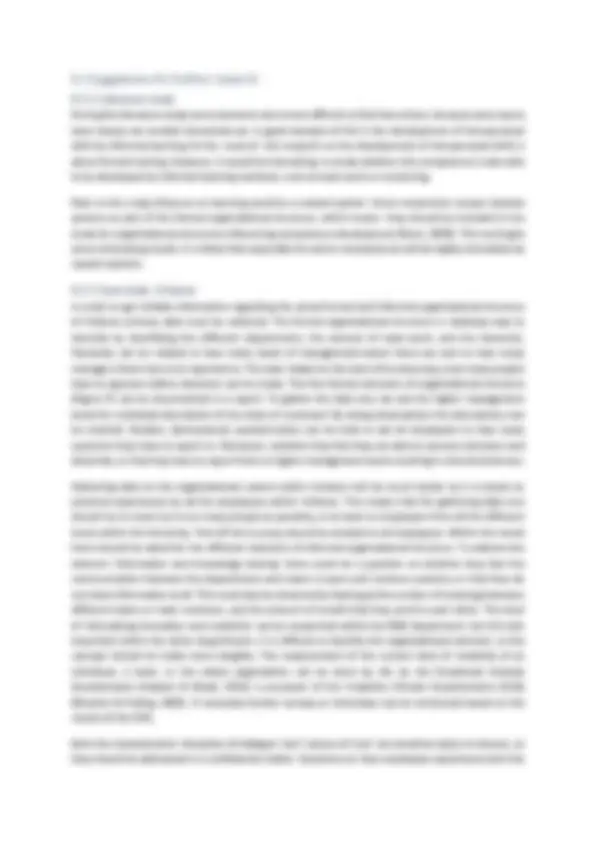
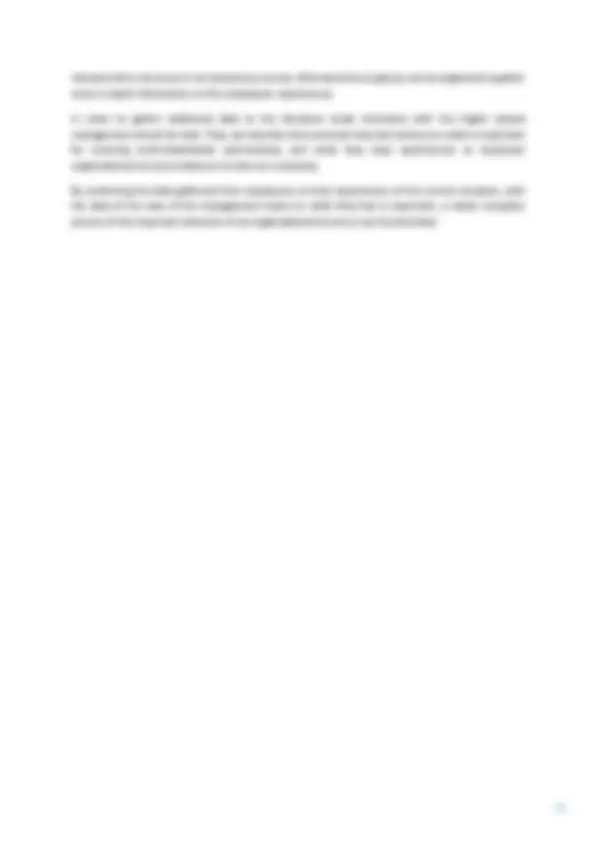
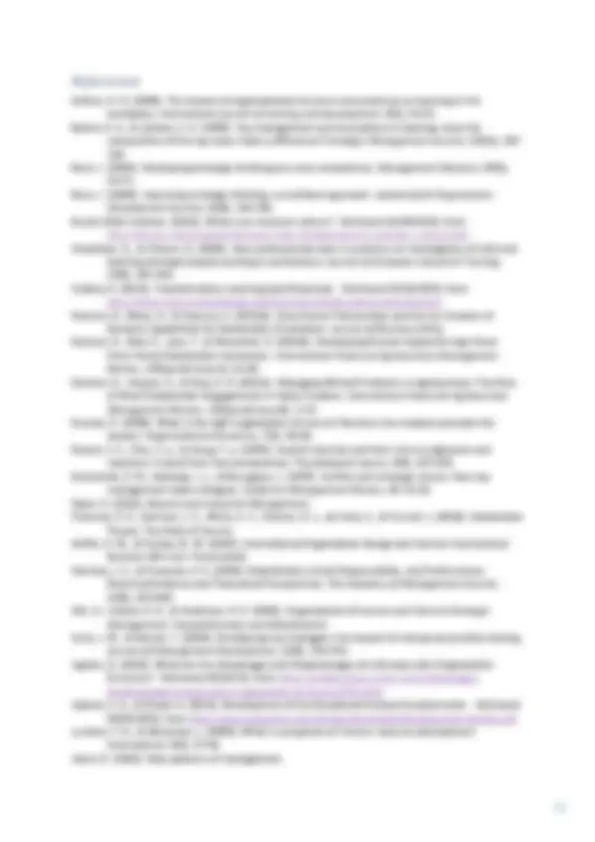

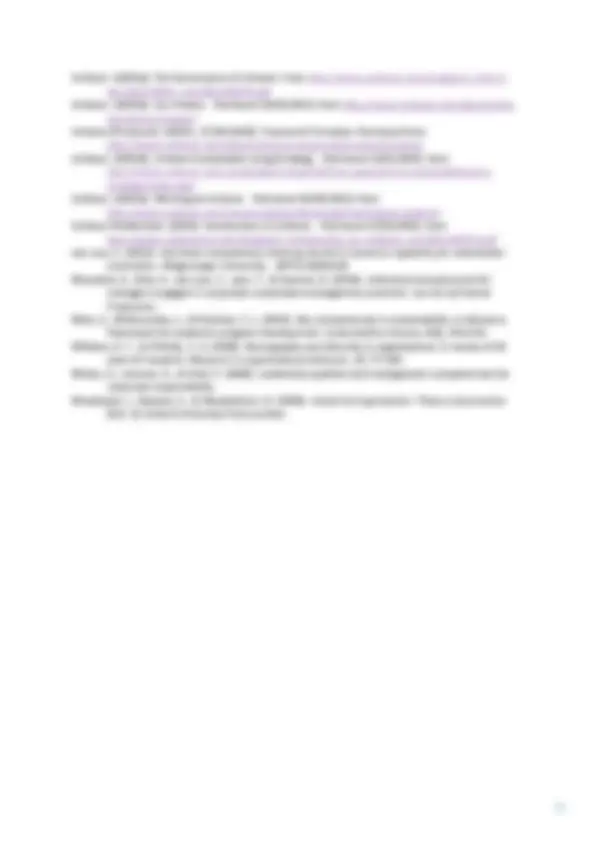


Study with the several resources on Docsity

Earn points by helping other students or get them with a premium plan


Prepare for your exams
Study with the several resources on Docsity

Earn points to download
Earn points by helping other students or get them with a premium plan
Community
Ask the community for help and clear up your study doubts
Discover the best universities in your country according to Docsity users
Free resources
Download our free guides on studying techniques, anxiety management strategies, and thesis advice from Docsity tutors
This bachelor thesis explores how Unilever's organisational structures enable the company to successfully manage multi-stakeholder partnerships for sustainability. The study examines both formal and informal organisational elements and their impact on individual competence development. Keywords: organisational structures, competence development, multi-stakeholder partnerships, Unilever.
Typology: Summaries
1 / 37

This page cannot be seen from the preview
Don't miss anything!






























“Organisational Structures Enabling Multi-Stakeholder Partnerships for Sustainability”
Wageningen University & Research Centre
Bachelor Thesis Management- and Consumer Studies; Major: Management
Course code: YSS- 81812
Student: Marieke Kil (Studentnumber: 940609435090 )
First Supervisor: Domenico Dentoni (Management Studies)
Second Supervisor: Renate Wesselink (Education and Competence Studies)
Date: 10 - 05 - 2015
Sustainable issues are usually wicked problems and need to be solved by involving many stakeholders. Growing pressure on organisations to invest in sustainability has thus stimulated a growth in the number of multi-stakeholder partnerships. Entering a multi-stakeholder partnership however, is not that straightforward. Previous research has identified which organisational capabilities and which individual competences are most favourable for an organisation in order to enter a multi-stakeholder partnership for sustainability successfully. This research tried to describe how the specific individual competences are developed, and which elements of both the formal and informal organisational structure foster this development. The individual competences, ‘systems thinking’, ‘embracing diversity and interdisciplinary’, ‘interpersonal competence’, ‘action competence’, and ‘strategic management’, are linked to informal learning methods that enable the development of the competences. The learning methods in turn are linked to five formal and four informal organisational structure characteristics. This means that the use of the informal learning methods as a connector enabled the identification of the relationship between the organisational structure elements and the individual competences. The five formal organisational structure elements that have been identified to foster the development of the individual competences are: 1. Divisional/Matrix structure; 2. Functional structure; 3. Low level of bureaucracy; 4. Flat organisation/Limited hierarchy; 5. Long-term multi-disciplinary teamwork. The organisational culture (informal) characteristics are: 6. Information and knowledge sharing; 7. Stimulating innovation and creativity; 8. Discipline of dialogue; 9. Culture of trust. Organisations can take these characteristics into account when they want to enter (more) multi- stakeholder partnerships. Changes to both formal organisational structure and the organisational culture are difficult to implement, but knowing about the organisational elements might encourage small steps towards a more sustainable organisation.
Unilever is an organisation that has been active in multi-stakeholder partnerships for several years. Therefore, analysing the formal and informal structure of Unilever might provide additional knowledge on organisational structures that are most favourable for entering multi-stakeholder partnerships. Unilever pays great attention to the development of their employees through formal training programs and projects, such as Unilever Future Leaders Program. However, in these formal project also informal learning methods, such as ‘role models and mentoring’ and ‘reflection, feedback and criticism’ are present. The formal structure of Unilever facilitates teamwork which is a stimulator of competence development. Moreover, Unilever focuses on the competence ‘embracing diversity and interdisciplinary’ already during the hiring process, as this is a competence that is rather difficult to develop.
To gain more knowledge from Unilever further research should be conducted. This should be in-house research focusing on gathering primary data. This will provide more reliable information than the secondary data that has been used so far. Questionnaires, interviews, and focus groups can be conducted and will be especially valuable to gather trustworthy information on the organisational culture within Unilever.
Keywords: multi-stakeholder initiatives, corporate sustainability, individual competences, informal learning, organisational structure, organisational culture.
This research will try to develop a theoretical framework which will explain how different formal, such as functional, divisional, and matrix and informal organisational structures can determine the development of individual competences, and especially those needed to enter MSPs for sustainability development. These findings will lead to conclusions on which organisational structures are most appropriate to successfully enter a multi-stakeholder partnership for sustainability.
The conclusions that this research will deliver will be of practical use for organisations that want to develop new structures and processes within their organisation that support sustainable development. Organisations can detect how their organisational structure influences the development of the individual competences of its employees and whether their organisational characteristics are those favoured to enter a multi-stakeholder partnership. If the individual competences are not those needed to successfully enter multi-stakeholder partnerships, the findings of this research can be used to make suggestions on the redesign of elements of the organisational structure.
The following question should be answered through the literature study in this research: Which elements of the different formal and informal organisational structures enable the development of the individual competences that are identified in order to successfully enter a multi-stakeholder partnership that aims on gaining sustainable development?
This research topic has resulted in the following sub research questions:
o what relationship exists between the individual competences and organisational capabilities that are needed to gain the dynamic capability of stakeholder orientation? o what are the main organisational structures that are identified? o what elements of an organisational structure influence the development of competences? o what implications do different organisational structures have on the development if individual competences? o what elements of an organisational structure are most favoured in order to develop the individual competences that are needed to successfully enter multi-stakeholder partnerships for sustainability
After the literature study a case study on Unilever will add to the literature study. The case-study is not meant to test the literature study, but to see whether in practice there might be other elements that should be taken into account; elements that have not been encountered in literature study so far. The findings on Unilever could also give suggestions for further research. In this way there can be tried to support the elements that are found in the case study by a subsequent literature study and/or case study.
In the case study the following question will be a guidance: How does the organisational structure enable Unilever to successfully manage multi-stakeholder partnerships?
Existing literature on individual competences and organisational capabilities and the relationship between these two concepts will be the basis of this literature study. Using this literature as a starting point there will be tried to find a link between organisational structures, and informal learning and competence development. The main research question demands that the three main organisational structures: functional, divisional, and matrix are analysed and the relationships between elements of the structures should be linked to the individual competences and their development. There is existing literature on the relationship between individual competences and organisational capabilities applied on multi-stakeholder partnerships. However, the influence of organisational structures on the development of the competences is not yet placed into the context of multi-stakeholder partnerships. The inclusion and exclusion of literature is thus dependent on whether there are already applications for multi-stakeholder partnerships or not. To find literature on the development of individual competences general keywords can be used. Examples of appropriate keywords are: competences, learning, informal learning development in combination with the context-related keywords: multi- stakeholder cooperation/alliance/initiative/partnership, and sustainability. In order to describe the influence of organisational structures more general literature on how organisational structures influence the learning processes, and thus the development of certain competences need to be find. Keywords that will be use are: organisational structures, competence development, organisational learning. It will not be possible to use the keywords on multi-stakeholder collaboration and sustainability, because this connection has not been described yet. This research will place the findings of the influence of organisational structures on the development of individual competences into the context of multi-stakeholder partnerships for sustainability. In the end, recommendations can be made about what organisational structure or what elements of an organisational structure are most likely to make entering a multi-stakeholder partnership for sustainability successful.
Next to the literature study a case study with an inductive approach will represent a practical application of the findings. The findings on the main research question will be compared with an existing organisation. This organisation has entered at least one multi-stakeholder partnership for development of sustainability. In the case study the structure of the organisation will be analysed. The case study has the intention to provide additional information next to the findings of the literature study. The next section introduces the case study organisation.
The corporate purpose of Unilever states that they strive for “the highest standards of corporate behaviour towards everyone we work with, the communities we touch, and the environment on which we have an impact.” This purpose demonstrates the importance of sustainability within the organisation. Next to this general purpose Unilever has another purpose considering sustainable living, that is “make sustainable living commonplace”. In 2010 Unilever launched their Sustainable Living Plan, which is a strategic plan on sustainability for the coming 10 years. What makes Unilever distinctive in their quest for sustainability is that their Sustainable Living Plan applies to their entire portfolio, and all countries they operate in. Unilever wants to make transformational changes, that is fundamental change to whole systems. To achieve this Unilever finds itself cooperating with governments, NGOs and others in the industry. The wide span of their sustainable goals can be recognized in the great variety of initiatives on multi-stakeholder interaction they have undertaken so far (Unilever, 2015d)
The four organisational capabilities that are demanded for acquiring the dynamic capability of stakeholder orientation are described in the conceptual model SILC. Explanations of SILC are based on previous research of Dentoni et al. (2012a).
Sensing: “the ability of identifying both existing and potential stakeholders and understanding their needs and demands.” Conflicting views among multiple stakeholder should be recognized, so should their dynamics and changing requests. Asses the resources and capabilities of a stakeholder and try to find new opportunities for collaboration. Interacting: “the ability of initiating, developing, establishing and strengthening ties with stakeholders.” Developing effective mechanisms to achieve set long- and short-term goals; together with both current and new stakeholders. Learning: “the ability of acquiring. Assimilating and transforming knowledge from stakeholders.” Establish adaptive procedures and routines that incorporates knowledge from stakeholders into organisational practices and processes. Changing: “the ability of using knowledge from stakeholders in organisational operations and strategies.” Reformulating and adjusting the organisational structure and organisational culture by means of stakeholder orientation. Creating different forms of innovation in cooperation with stakeholders, and reallocate resources and capabilities based om stakeholders’ advice and pressure.
Previous research intended to map the relation between individual competences and organisational capabilities. However, it was found that such a (causal) relation does not exist (van Leur, 2013). Consequently an extra variable has been introduced which was then linked to the competences respectively the organisational capabilities. By analysing the semi-structured interviews with four large agribusiness companies van Leur ( 2013 ) could identify which core activities take place in the process of multi-stakeholder collaboration; this resulted in a list of a total of nineteen activities.
It was found that in the relation between the individual competences and the core activities only five competences could be validated; that have a significant correlation with one or more of the core activities. The results of this analysis are integrated in an overview of validated competences , which is presented in Figure 1.
To map the relation between the core activities and the four SILC elements van Leur ( 2013 ) carried out another correlation analysis. This resulted in an overview of the four elements: Sensing, Interacting, Learning, and Changing and their associated core activities within the process of stakeholder collaboration. The overview is presented in Figure 2 (van Leur, 2013).
The two Figures previously mentioned (Figure 1 & Figure 2) show that both the individual competences for sustainable development as well as the dynamic organisational capability for stakeholder orientation are related to the process of performing multi-stakeholder collaboration. Consequently both concepts can be related to each other through this extra variable of core activities. The relationship between these three concepts is represented in Figure 3.
In the upcoming sections of the report the development of the individual competences under influence of elements of different organisational structures will be discussed.
Figure 1: overview of validated competences (van Leur, 2013)
Figure 2: overview results SILC correlation analyses with core-activities (van Leur, 2013)
The early literature on organisational structures focused on formal structures, the set of official, standardized work relationships built around a tight system of formal authority. Fayol ( 1916 ) is one of the first to describe the principles of management including the element ‘organizing’, which refers to building up the structure, both material and human. Halfway through last century new observations made researchers aware of the existence of an informal structure next to the formal structure (Likert, 1961 ). Different school of thoughts existed; they were either supporting the formal or the informal structure as the one that should be relied on. However, later it was found that the two structures are intertwined and often indistinguishable (Mintzberg, 1979). This means that within an organisation there are two types of structure that exist next to each other: the formal structure which is mainly concerned with the relationship between authority and subordinates, and the informal structure which deals with the human processes in an organisation (Woodward et al., 1965).
There are different formal structures that address the different division of tasks and the associated scalar principle. The following paragraph will describe the three main organisational structures: functional, divisional and matrix, and the advantages and defaults of these structures (Price, 2011).
Functional Organisation: this structure is based on grouping employees into organisational units according to the function they perform. An example of such a functional division is that those employees responsible for dealing with customers and markets are in the marketing division and those dealing with finance are in the financial department. In large organisations each of these divisions can be subdivided in smaller groups to ensure good coordination. The main advantage of this structure is that the resources are used better and more efficiently, because the people who share a common expertise are grouped together with the facilities and resources needed. Moreover, the communication within the divisions is relatively easy due to the common background in professional terminology and similar interests. However, the inter-divisional communication might be especially difficult due to different goals, different interest and different backgrounds of the members of these organisational units. For a customer this can be problematic when he/she needs a service, product or information that is engaged in multiple divisions. Also, employees can feel that their divisional goals are superior to the overall goals of the organisations. This lack of alignment of the divisions can lead to a poor overall performance of the organisation. The functional organisation is quite hierarchic and authority and responsibility are strictly defined; this makes for a clear ’line of command’. Over the years each organisational units develops a stable, almost traditional way of working. This makes this organisational structure mainly appropriate for relatively stable markets. The lack of communication between, and alignment of the divisions makes that the organisation will not be able to respond fast enough to (rapidly) changing markets.
Divisional Organisation: in a divisional structure the organisation is divided in a set of divisions. Each division is a combination of different functions that produce a product or service. There a different characteristics on which a division can be based; examples are: divisions per region, per product type, and per consumer type. Divisions can be seen as rather independent business units that can also have their own departments, such as marketing, research, and manufacturing. The divisions ensure good coordination between functions, and allows units to adapt to differences in products, regions, and
consumers. The self-containing divisions are less hierarchical than the functional structure. Authority is delegated more, so the performance can be directly measured within each division or department. This results in better performing managers and a higher morale of the employees. Moreover, the divisional structure and its self-containing business units makes the organisation much more adaptive to unstable environments and rapidly changing markets. In the functional organisation there was a limitation of communication between the different disciplines. That issue is solved by adapting the divisional structure. However, now the resources are not pooled together. The advantage of a functional structure is actually the default of the divisional structure: by separating all the specialists resources are not used efficiently and as a result a lot of extra and unnecessary work is done. Furthermore, it is possible that the employees will feel more affiliated towards the goals of their own division or department rather than goals of the organisation as a whole. Hence, the objectives of the organisation are not prioritized. The collaborations between different specializations provide the employees with opportunities for learning new skills. However, in contrary to the functional structure, the distribution of the specialists across the different divisions eliminates in-debt competence and technical specialization. Moreover, there is less possibility to create economies of scale and standardise across the different product lines. The divisional structure is most appropriate in large organisations with a broad portfolio of products, and in organisations that have an unstable, competitive environment.
Matrix Organisation: to overcome some of the problems of the functional and divisional structure a combination of the two structures was developed: the matrix structure. The basis of this structure is the functional organization, but employees now have multiple reporting lines. Besides the functional organisation units, there are also separate teams for the different projects or products. This implies that employees can be a member of multiple teams, and thus have multiple managers to report to. There is a horizontal as well as a vertical line of authority. An example of a matrix organisation is represented in Figure 3.
Figure 4: matrix organisational structure (Shtub & Karni, 2010)
believe that attributes are fixed and trait-like entities, they tend to understand outcomes and actions in terms of these fixed traits.” This is the so-called entity-theory. Contrary, the incremental theory explains that when people believe that attributes are more dynamic and developable, they tend to understand outcomes and actions more in terms of specific behavioural and psychological mediators. Consequently, people or employees that belief in the malleability of their competences have more motivation to improve, or even develop them.
Maurer et al. ( 2003 ) places these improvability beliefs within a learning and development model. Self- efficacy and improvability are related, but separate concepts. The improvability beliefs reflect ones perceptions on the malleability of personal characteristics and individual competences. However, self- efficacy for learning and development reflects self-confidence for actually increasing those personal characteristics. It means that the improvability belief is bound to an individual within a specific context and situation. Although someone has an incremental theory of competences, the person might feel he or she does not have the actual possibilities or skills to develop its competences. “Thus, both context and situational variables contribute to self-efficacy for development, independent of the person’s implicit theory.” This reasoning stresses the importance of the structure of an organisation. It is the organisational structure that has an influence on those context and situational variables, and thus influences the development of competences. This will be discussed more elaborate in paragraph 5. and 5.2.
The learning and development of competences can be done in several manners, but should, according to Dentoni et al. (2012b) take place in authentic situations. For employees this means that they should receive feedback and reflect on actual experiences they had. Employees can then collectively learn from solving and dealing with these problems. To organise this feedback and reflection moments several interventions can be introduced. One of these interventions is the sharing of knowledge with competitors and stakeholders. ‘Learning’ is therefore also an important argument for organisations to take part in multi-stakeholder collaborations. Other interventions that are available are: scanning external information, benchmarking, learning from failure, implementation of formal feedback and reflections systems, development of metrics and internal knowledge sharing across functional areas and business units.
Learning within an organisation is very important for the development of competences. To enable the employees and managers to participate in this learning process some elements of an organisational structure are more suitable than others. Mills and Friesen ( 1992 ) explain four characteristics a learning organisation must possess: 1. It should possess mechanisms which transfer learning from an individual to the group; 2. It must make a commitment to knowledge; 3. It must have a mechanism to renewal within itself; 4. It should possess an openness to the outside world. Cheetham and Chivers ( 2001 ) among others have described in detail how employees learn in practice. Combined with the areas where organisational structure and culture impacts the learning process (Ashton, 2004) the learning methods that are expected to be influenced by the formal or informal structure of an organisation are described.
Practice and Repetition: the saying ‘practise makes perfect’ seems to be valid for the process of learning. Iteration of actions improves the proficiency of these actions. It is thus important that one is able to repeat job-related task several times. This will improve the associated competences. An
organisation that has a structure in which teams are only temporary will hinder this learning method. This project-based organisational structure forms teams that will be disbanded after finalizing the project. Because most projects are unique and only occur once the processes of organisational learning are not well developed. Considering formal organisational structures there is not one structure that is clearly preferred over the other structures. To enable this learning method one should be able to repeat certain task various times. Although diversity in a job has its advantages for ‘practice and repetition’ a certain consistency in the job-related tasks is required. Specialisation leads to a narrower job description which results in more repetition of tasks. Specialisation is most likely to exist in an organisation that follows the functional structure. In a matrix structure repetition will take place, but most likely not in one specific task. This means that the learning process is broader, considering a higher diversity of tasks. It is different per organisation which learning process is preferred: specialisation in one task, or development of a broader variety tasks. The following organisational elements influence the learning method ‘Practice and Repetition’: Divisional/Matrix Structure , Functional Structure and Long-Term Multi-Disciplinary Teamwork.
Role Models and Mentoring: not every individual values learning through role models. Most people that have claimed role models useful said they were influenced by several different people rather than one single person (Cheetham & Chivers, 2001). Furthermore they mostly copied behaviour or a certain way of doing things rather than a particular individual’s behaviour. The learning method of role models can be influenced by both the formal and informal organisational structure. One possibility is to have formally-appointed mentors that can guide employees in their actions and decisions. Next to formal mentoring individuals also seem to develop unofficial mentoring relationships. These relationships are mostly dependent on the informal organisational structure. These individual mentor relationships are usually more efficient when entered into with a more experienced or higher ranked colleague. The more the organisation has informal elements, the more the number of role models an employee would have, and thus the more the learning. This means that the informal organisational culture should stand for sympathetic feelings towards employees that stand either higher or lower in the organisational hierarchy. Preferably the organisation is not that hierarchic at all. In a hierarchic organisation the formal distances between employees hinder the existence of informal relationships with superiors. The following organisational elements influence the learning method ‘Role Models and Mentoring’: Flat Organisation/Limited Hierarchy , Discipline of Dialogue and Culture of Trust.
Being Challenged and New Experiences: experiencing new situations or problems and acting upon them stimulates learning and the development or improvement of various competences. To be challenged in your job helps broaden your knowledge and experience. For this learning method to occur organisations need to create opportunities for their employees. In particular opportunities to operate at a higher level of task complexity than the level they are used to (Cheetham & Chivers, 2001). The organisational structure must enable employees to stand in for a senior colleague. However, when an organisation is charged with time constraints it might be difficult to include (lower-ranked) employees in the decision-making process due to the time it takes to have extensive deliberations (Tannenbaum & Schmidt, 1958). Next to this, superiors must be open to new ideas; also when they come from lower-ranked employees. This will lead to pioneering and innovative experiences that have been identified as valuable sources of development. The implications for the formal as well as the informal organisational structure are that the organisations must be open to new ideas and innovations (Martins & Terblanche, 2003); or at least should not be persistent to hold on to the status quo. For the informal structure it also implies that there should exist a culture of trust, especially
It can be concluded that the informal culture of an organisation is really important to enable informal learning. The organisational culture should be streamlined and have a relatively flat hierarchy. Because boundaries limit the flow of knowledge and keep individuals and groups isolated a learning organisation should minimalize its boundaries and cut bureaucracy. The organisation must create opportunities for its employees. Moreover, the relationship between employees must be of a nature that is sympathetic and open to dialogue, mutual constructing criticism, and advise.
In order to improve the competences of the employees they must have the intrinsic motivation to do so. This is partly dependent on the learnability belief: the belief whether a competence is in principle learnable, or not and thus an intrinsic characteristic (Maurer et al., 2003). Whether an employee has the intrinsic motivation to think creative and invest in its own competence development also depends on the satisfaction with their job. Interest in, satisfaction with, and the challenge of the work itself will determine the motivation of an employee; not the external pressure by superiors (Bonn, 2001).
The following paragraph will describe how the individual competences that were described in chapter 3.3, systems-thinking, strategic management, embracing diversity and interdisciplinary, interpersonal competences, and action competences, are affected by the different learning methods described in chapter 4.3. Moreover, there will be discussed how, through these five learning methods, elements of the formal and informal organisational structures are related to the individual competences.
Systems Thinking: Bonn ( 2005 ) argues that systems thinking is a key element for the more overarching competence of strategic thinking. To understand the concept it is important to know what exactly is regarded as a system. Senge (2010, p. 90) describes a system as “a perceived whole whose elements ‘hang together’ because they continually affect each other over time and operate toward a common purpose”. Systems thinking demands that one can recognize and acknowledge the positive as well as the negative consequences of decisions made and actions taken. To get this integral perspective of an organisation it requires a thorough understanding of both the internal and external dynamics. One of the most efficient ways of learning this particular competence is therefore through practice and repetition and, even more important, reflecting on own actions afterwards. Continuously reflecting decisions and their consequences enlarges the knowledge of the different subsystems within the organisation and the reactions of the sub-systems to each other (Bonn, 2005; Stacey, 1996). The systems thinking competence embodies the idea that you cannot make changes while not regarding the system as a whole. This implies that you cannot practice systems thinking as an individual, but should incorporate multiple perspectives. The learning method ‘team working and multi-disciplinary working’ is most likely to let the employee get acquainted with the different perspectives and disciplines that are used in developing the systems thinking competence.
Strategic Management: this competence has been identified as most learnable. Strategic management requires one to “collectively design projects and implementing interventions, transitions, and strategies towards sustainable development” (Dentoni et al., 2012b, p. 65). Because strategic management requires knowledge on various strategic concepts especially formal training will benefit the development of this competence. However, there are also some informal learning methods that will advance the development of strategic management. Next to extensive knowledge, experience is requisite to enhancing strategic management skills. Experience can be gained through own performances, these are achieved by the learning method ‘practice and repetition’. To optimize this learning process the learning method ‘reflection, feedback and criticism’ should always be conducted after and during performances. At last, the learning method ‘role models and mentoring’ can be useful as well. This method will not make an employee learn from own experiences, but from other